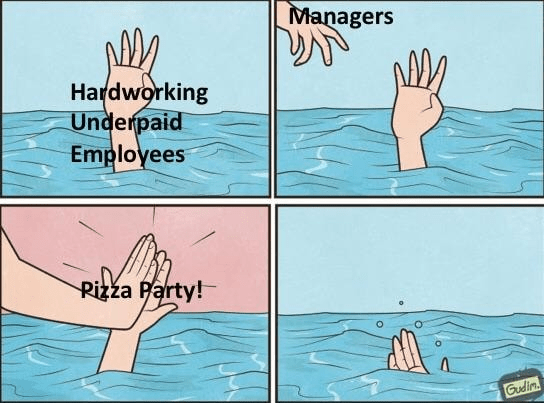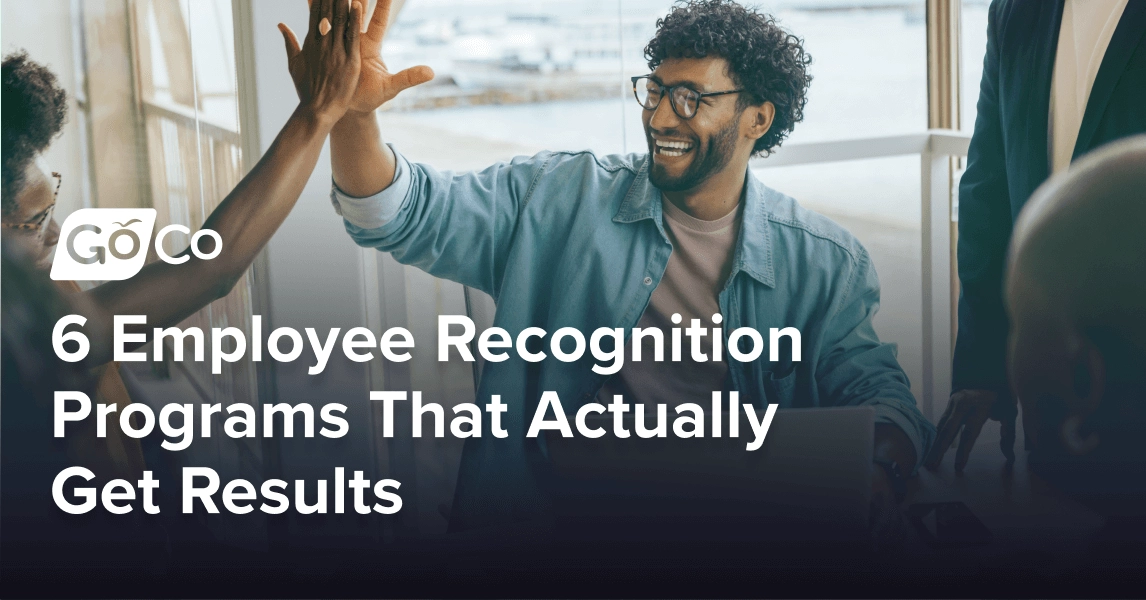6 Employee Recognition Programs That Actually Get Results
Learn how to create employee recognition programs that include multiple strategies for a unique and engaging experience.
by Amanda Cross - September 23rd, 2024
There is a recognition gap in the workplace where companies depend on employees to do great work, but small things like saying thanks aren't part of the company culture. Research from Workhuman and Gallup found that 36% of employees say their organizations have an employee recognition program. Considering the impact, more companies must adopt a program encouraging and rewarding employees. But exactly what is employee recognition?
What is an Employee Recognition Program?
An employee recognition program is a multi-pronged incentive to help employees feel more appreciated for their work. With voluntary turnovers increasing, employee recognition programs help companies retain their best people.
Download The Ultimate Onboarding Checklist
Benefits of an Employee Recognition Program
As you consider how to create an employee recognition program, you must understand why it matters. Recognition isn't always easy to fight for. The Workhuman and Gallup poll found that a whopping 73% of senior managers say their organization doesn't offer leaders advice on recognition! When you know why it matters, you can make a case to invest in your company's recognition program.
Employee recognition improves retention
Workhuman and Gallup shared that employees who are recognized often are 56% less likely to be looking for other work opportunities. As The Great Resignation continues to impact work, it's essential to keep employees happy so they can stay off job boards.
Employee recognition helps you spot future leaders
One building block of a successful recognition program is peer recognition. When you utilize software or make space for peer recognition in meetings, you see leadership qualities in all your team members.
Learning about how an employee helped someone else close a deal or worked tirelessly on a presentation empowers leaders to think outside the box. Before you know it, new people can get involved in upcoming projects and leadership positions.
Employee recognition encourages positive workplace behaviors
Positive reinforcement, or rewarding positive behavior, significantly impacts work. When you can quickly give feedback and encouragement, you let employees know to continue that behavior. Humans want to avoid negative outcomes in favor of positive ones. You'll get more positive behaviors by praising employees when they do good work.
Recognition must follow the three Rs to improve workplace behaviors. You should reward the right behavior at the right times and in the right ways. The three Rs are covered further in a recent piece on employee engagement.

File this image under "ineffective employee recognition strategies" 😅
Ideas for Employee Recognition Programs
Now that you understand why employee recognition programs are important, what are some employee recognition ideas? Often what you can do starts with the budget you have. Some recognition can be free or cheap, but others have a significant cost.
Ultimately, recognition programs should be multi-pronged. Using multiple forms of recognition will help create a unique and valuable employee experience. Here are some of the most popular employee recognition ideas.
1. Bonuses
One way you can quickly engage employees and show recognition is incentive pay. Harvard Business Review found in their research that bonuses related to performance can positively impact employees. When giving out spot, project, or performance bonuses, it's vital to ensure that incentives are available to all employees. When incentives were kept for a few workers, HBR found that bonuses didn't help employees feel recognized or loyal to the company.
2. Raises and Promotions
While bonuses give employees a one-time boost in pay, raises provide a more sustained bump. It's essential for employees to feel like they are moving forward at work. Raises or promotions can be one of the most substantial ways to recognize employees for their contributions to the company.
3. Peer Recognition
Peers see things that managers don't see. Many companies have invested in peer recognition software to leverage this insight. According to Top Employers Institute, "62% of Top Employers have a platform to support peer-to-peer recognition." Peer recognition programs give insight into who's giving and receiving recognition so you can support future company leaders. Getting more public recognition will also positively impact your team members.
As a bonus, most peer recognition programs revolve around company core values. So by using these systems, you ensure your team understands what behaviors your company values.
4. Profit-Sharing
Profit-sharing is a method of acknowledging employees for their contributions to making a company successful. It is often used by companies, particularly those in the tech industry, that are responsible for generating profits for investors. By implementing profit sharing, these companies enhance employee motivation by allocating a portion of the profits to be shared among the employees. When developing a profit-sharing program, it is important to prioritize employee flexibility. The most effective plans enable employees to immediately reap the rewards of company gains rather than solely relying on the company's potential future public offering.
5. Performance Reviews
For many employees, performance reviews are the ultimate way they receive employer feedback. Unfortunately, some employees don't get frequent feedback from managers, which can cause work issues. Therefore, it's essential to consider your performance management process. One easy way to improve this process is to work on writing performance reviews. What you share during these reviews can profoundly impact your employees and their career growth within and beyond your company.
6. Saying Thanks
As easy as it sounds, one of the most common ways to share recognition at work is by simply saying, "Thank you!" According to a recent report from Workhuman, recency in receiving thanks can impact whether someone intends to leave an organization. Their study of over 3,000 workers found that employees who had received thanks recently were less likely to be looking for new work.
Examples of Employee Recognition Programs
Companies with excellent employee recognition programs consistently outperform their competitors. We've compiled the top 5 companies that go above and beyond to create an employee-centric culture. These employers have implemented outstanding initiatives and practices in their workflows to ensure employees feel seen, valued, and respected for their contributions. As companies look to invest further into company culture, these organizations and their employee recognition examples are worth emulating.
1. Gorilla Glue
Gorilla Glue tops the list of companies known for their incredible employee recognition culture, mainly through their "People Committee," which is dedicated to ensuring employees feel valued. They believe in empowering their employees to be innovative and creative and recognize the strength of loyalty among their team members.
2. Groupon
Groupon acknowledges the hard work of their employees in several ways, one of which is their Grouponiversary program. Every employee's job anniversary deserves recognition. Groupon doesn't just issue a certificate or reward on these anniversaries – they truly show appreciation with surprises and thoughtful gifts. This proves how much value Groupon puts in celebrating each employee and their contributions to improving their work environment.
3. Walt Disney World
While Walt Disney World is known for its magical parks, cruises, and entertainment, it should also be recognized for its commitment to celebrating employees. The company's comprehensive recognition program acknowledges the hard-working cast members who make dreams come true daily and ensure an exceptional guest experience. Each year, top performers are recognized with the award ceremony of a lifetime, and many top employees are immortalized throughout the park.
4. Patagonia
Patagonia is known for its outstanding employee recognition culture. They have a unique and irreverent company culture in which working to benefit a collective is praised and rewarded. They genuinely invest in their employees' well-being, encouraging paid time off to seek out personal passions. Unsurprisingly, 91% of their employees say they love where they work! Patagonia continues to set the bar higher than ever when fostering cultures of rewarding contexts for individual and collective growth.
5. Ben & Jerry's
Ben & Jerry's is more than just a company of ice cream aficionados; it's also an advocate of equity and justice for historically marginalized communities. They understand that their success depends on every employee's contributions, so they have built a unique culture that emphasizes people first.
Not only are their employees supported in reaching their full potential, but they are also encouraged to grow together. This focus is exemplified by its mission statement, which holds the company responsible for safeguarding and progressing these initiatives regardless of the external shifts in culture or climate.
Best Practices for Implementing an Employee Recognition Program
Any organizational change takes 18 to 24 months to fully take hold, which means that an employee recognition culture won't happen overnight. Here are four ways to help move your organization or office in that direction.
1. Start at the Top
Any type of culture shift within an organization must have senior leadership support. Without them walking the talk, the change won't happen. No way, no how!
2. Empower Your Employees
Map out a formal employee empowerment policy, whether it's the ability to recognize employees on their own or make business decisions. The responsibility one has can make a difference in the level of engagement and care one takes in their work.
3. Promote fun
Employees that play together stay together! Make your workplace fun and ask your staff what they want and need to stick around using employee town halls, stay interviews, or employee surveys. You don't know if you don't ask.
4. Shower your team with affection
Employees need to be recognized in both formal and non-formal settings, public as well as private. Sometimes all it takes is a quiet thank you to help drive results, while others enjoy receiving employee awards. Individual employees prefer different recognition methods. Take your time and do your homework before you execute a program.

Another example of "how not to do employee recognition" 🍕🙃
How to Measure the Results of Employee Recognition Programs
So, you've put your program in place for a while. How do you measure the results of the program, and how do you know your recognition motivates employees? Ultimately, feeling recognized is subjective. You'll collect a lot of data based on feelings vs. hard numbers. Subjective data can be challenging, especially when selling the success of a recognition tool to the executive suite. By using several measures to understand the results of your program, you'll be able to talk about its success confidently.
Ask for Feedback
One of the easiest ways to measure the results of your program is to ask for feedback. Sending out another pulse survey may not get the results you'd hoped for. Instead, have a quick face-to-face conversation – employees can tell you a lot about their experience in ten minutes. When you sit in front of an employee, you can ask follow-up questions and have more context for your answers. Here are some example questions to ask during your quick feedback session:
When was the last time you received positive feedback?
How often do you receive feedback from:
Company leaders/executive team members
Managers
Coworkers
Customers
Are you happy with your current level of recognition at work?
Tell me about a recent time when you felt you deserved recognition but didn't get it. What about a time when you earned recognition and got it? How did both make you feel?
What would you do if you could change one thing about our current recognition program?
Utilize Recognition Software Data
If your organization is utilizing a peer recognition platform, you have numbers to measure the results of your program. Download and analyze the data to see your program's month-over-month growth.
Who is getting recognized? Who isn't?
How many times have people been recognized?
Are there any words or phrases that show up often during recognition?
Measure Employee Engagement Changes
Lastly, you'll want to measure employee engagement lift. If your company sends quarterly engagement surveys like Gallup's Q12, you already have a baseline of how engaged employees are at your company. Have these scores been lifted since you unveiled your recognition program? Specifically, look at any questions on your survey related to being recognized, workplace relationships, or satisfaction. If you see improvements in these scores after implementing your program, you know it's working.
Employee recognition programs are more than platitudes to keep your employees from leaving. When taking employee recognition seriously, your company culture shifts. Staff members work hard and want to feel the weight of their work. Recognition helps employees feel good, which encourages them to do good work.
On your way to creating a recognition culture, GoCo can help. GoCo's award-winning performance management software and management workflows to manage promotions and employee surveys help organizations build better company cultures. Take a tour of GoCo to see how this software can fit into your HR tech stack.
Updated 9/23/2024
Recommended Posts
How To Retain Employees In 2023: 15 Strategies For HR
Blog Articles
23 Incentive Programs That Employees Love
Blog Articles
22 Employee Engagement Ideas That Remote Workers Love
Blog Articles
Search...
Product
GoCo
Resources
Articles
eBooks
Webinars
Customer Stories




